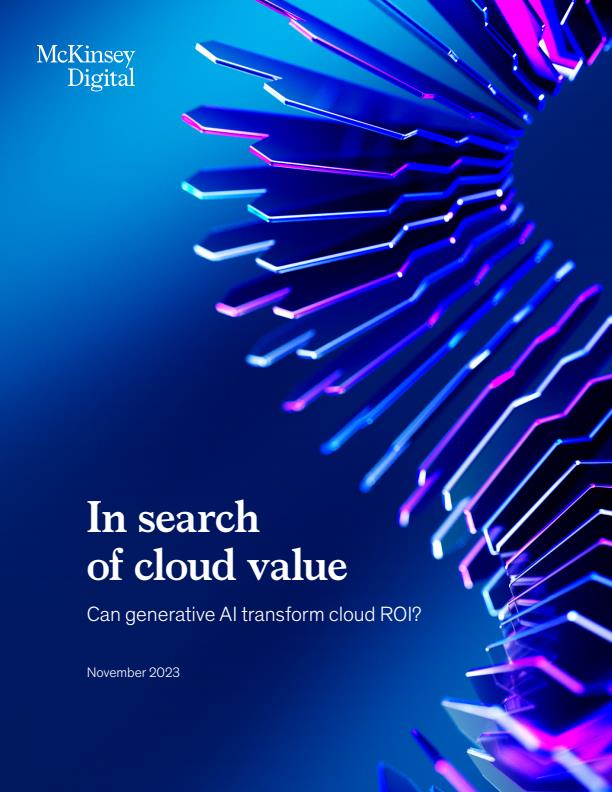Established companies face a quandary as they look to exploit cloud: as attractive as the benefits may be, the scale of change and investments required to adopt cloud platforms make generating an attractive return on investment (ROI) a challenge. But generative AI may significantly shift that value equation. It has the potential to dramatically reduce the investment and time needed to adopt cloud and generate new value by unlocking new business and tech use cases.
As a median, large companies run only 15 to 20 percent of their applications in cloud, even when they have been running cloud programs for years and even after they account for the use of software-as-a-service (SaaS) products. And it does not appear that there has been a dramatic uptick in adoption over the past year—companies with cloud programs profiled by McKinsey have increased their cloud adoption by only 5 to 10 percent over the past 12 months. Aspirations for cloud adoption, nevertheless, remain high. Almost all of the more than 80 enterprises McKinsey profiled for its CloudSights database aspire to run the majority of their applications in public cloud within five to seven years; more than two-thirds aspire to run 80 percent of their systems in cloud.
What is the reason for this disconnect between aspiration and reality? Getting value from public cloud, it turns out, is complicated. Companies have spent the past several decades building enterprise technology organizations, processes, and architectures designed to work for on-premises environments. Much of that needs to change.
Generative AI could transform the cloud investment-and-return equation. When McKinsey gathered nearly 80 CTOs and cloud program leaders together this fall, we heard that many believe generative AI may be a disruptor that transforms ROI dynamics for cloud programs and accelerates cloud adoption.
There are two elements to this opportunity. One is using cloud to support generative AI initiatives. With its massive calls on compute, storage, and networking, generative AI needs cloud to scale. Generative AI’s complexity, moreover, requires implementation via scalable enterprise cloud platforms rather than via disconnected pilots and initiatives run by individual development teams.
The second element of opportunity is using generative AI capabilities to accelerate cloud programs. Currently, remediating some applications to run effectively in cloud typically requires investments equal to several years’ worth of support and maintenance costs. Early efforts to apply generative AI to application remediation and migration have indicated a 40 percent reduction in time and investment required, though much work still is needed to understand how the improvements apply for different types of applications. The creation of end-to-end, generative AI–enabled workflows will create incentives for companies to migrate existing transactional applications to cloud.

Cloud by McKinsey Insights
The findings in this report paint a detailed picture of where cloud’s overall value lies and what it takes for companies to capture their fair share of it. Following are some of the highlights:
- Cloud can generate about $3 trillion in EBITDA by 2030.
- The value cloud generates from enabling businesses to innovate is worth more than five times what is possible by simply reducing IT costs.
- Across sectors, the potential EBITDA uplift from cloud by 2030 averages 20 to 30 percent over the projected baseline, but it varies significantly by sector, with the greatest potential in high tech and the least in electric utilities.
- Asian companies have the most to gain from cloud, with $1.2 trillion in EBITDA by 2030 at stake, driven by a higher rate of baseline revenue growth and more room to grow. American institutions stand to capture about $1.1 trillion in cloud value, while European institutions may have a somewhat smaller opportunity of $773 billion, primarily due to regulatory headwinds.
- An average company adopting cloud today could achieve 180 percent ROI in business benefit, although few are getting close to these returns.
- Only 10 percent of companies have fully captured cloud’s potential value, while another 50 percent are starting to capture it, and the remaining 40 percent have seen no material value.
- Nearly 40 percent of companies now say “business value” determines which applications move to cloud—up from 27 percent in 2021 and 2022.
- Companies that have captured the most ROI consistently do three things well: work closely with business leaders to focus on high-value business cases, build a robust cloud foundation, and adopt a product-oriented operating model.
- Lost value in cloud programs comes from three primary sources: unrealized use cases (focusing on IT savings rather than new value), cloud sprawl (redundant cloud foundations), and stalled adoption (breakeven generally comes at around 50 percent cloud adoption). Taken together, these three factors can completely erase the benefits cloud can provide—and even destroy value.
- Generative AI can add 75 to 110 percentage points of incremental ROI to cloud programs through three key benefits: unlocking new business use cases; reducing the time and cost of application remediation and migration (early results suggest 40 percent lower time and costs); and increasing the productivity of application development and infrastructure teams on cloud (exhibit).

- Going forward, companies can build generative AI into their cloud programs in a number of ways: incorporating generative AI–enabled business use cases; accelerating migration of on-premises transactional systems to build end-to-end generative AI–enabled customer journeys; and using generative AI to transform the ROI of application remediation and migration. To ensure the safe and efficient operation of generative-AI capabilities in cloud, they should be built into the entire cloud program, from foundational platforms to FinOps tooling and security capabilities.
This report is organized around the top three questions business leaders need to answer to get more value from their cloud programs:
Part I: What is the true value of cloud? This section breaks down all the sources of value from cloud across three areas: IT productivity, business innovation, and advanced technologies, including where generative AI can expand the value from cloud adoption. We look at how this value plays out across industries and geographies. Part I also digs into the root causes of why many cloud programs struggle.
Part II: How can my company maximize its cloud ROI? This part of the report explores how organizations can balance cloud investments against the expected benefits they will generate (including the transformation of ROI dynamics through generative AI), enabling them to plan for and prioritize their migration journeys. Part II also lays out some of the different pathways organizations may choose for their cloud programs and how each path might affect the ROI trajectory.
Part III: What actions should we take? This section turns to practicalities and lays out the ten essentials—actions that institutions can take right now to build healthy cloud programs and maximize ROI. We organize these ten actions around three broad areas:
- Discover the full value.
- Solve critical technical problems to enable the business to capture the value.
- Deliver the necessary organizational change. We also show what cloud programs need to do to support generative AI capabilities.
For the full version of this report, download the PDF.



